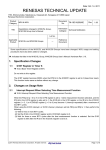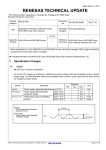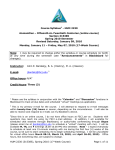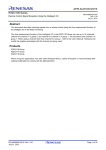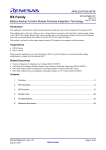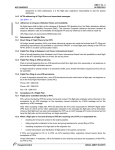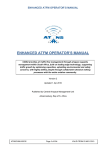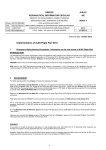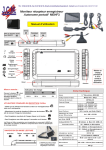Download Descriptions changed in M16C/5M Group,M16C/57 Group User`s
Transcript
Date: Oct. 14, 2011 RENESAS TECHNICAL UPDATE 1753, Shimonumabe, Nakahara-ku, Kawasaki-shi, Kanagawa 211-8668 Japan Renesas Electronics Corporation. Product Category Title MPU & MCU Document TN-16C-A204A/E No. Descriptions changed in M16C/5M Group, M16C/57 Group User’s Manual Information Category Technical Notification Rev. 1.00 Lot No. Applicable Product M16C/5M and M16C57 Groups — Reference Document Some specifications of the M16C/5M and M16C57 Groups have been changed. MCU usage and setting procedures have also been added or changed. Ä: Indicates the titles in the M16C/5M Group, M16C/57 Group User’s Manual: Hardware Rev.1.10. 1. 1.1 Specification Changes G1BT Register in Timer S Ä 18.2.5 Base Timer Register (G1BT) Do not write to this register. The G1BT register becomes 0000h when the BTS bit in the G1BCR1 register is set to 0 (base timer reset). This function works same as before without any change. 2. 2.1 Changes on Usage Note Interrupt Request When Selecting Time Measurement Function Ä 18.5.6 Interrupt Request When Selecting Time Measurement Function When the FSCj bit (j = 0 to 7) in the G1FS register is set to 1 (time measurement function selected), and the IFEj bit in the G1FE register is also set to 1, the G1IRj bit in the G1IR register, or the IR bit in the ICOCiIC register (i = 0, 1) or ICOCHjIC register (j = 0 to 3) may become 1 (interrupt requested) after a maximum of two fBT1 cycles. When using the IC/OC interrupt i or IC/OC channel j interrupt, set bits FSCj and IFEj to 1, then perform the following. (1) Wait for two or more fBT1 cycles. (2) Set the IR bit in the ICOCiIC register and/or ICOCHjIC register to 0. (3) Wait for three or more fBT1 cycles after the time measurement function is selected. Set the G1IR register to 00h after the IR bit in the ICOCiIC register is set to 0. (c)2011.Renesas Electronics Corporation. All rights reserved. Page 1 of 2 RENESAS TECHNICAL UPDATE 3. Date: Oct. 14, 2011 TN-16C-A204A/E Additions and Changes on Usage and Setting Procedures 3.1 User Boot Mode Program in Flash Memory Ä 29.11.4.1 User Boot Mode Program in Notes on Flash Memory Following notes have been added to the user boot mode description: • When using user boot mode, make sure to allocate the program to be executed to program ROM 2. • The LVDAS bit in the OFS1 address and bits WDTRCS1 and WDTRCS0 in the OFS2 address are disabled in boot mode. • When restarting the MCU in user boot mode after starting it in user boot mode, RAM becomes undefined. • If addresses 13FF8h to 13FFBh are all 00h, the MCU does not enter standard serial I/O mode. Therefore, the programmer or on-chip debugger cannot be connected. • As the reset sequence differs, the time necessary for starting the program is longer than in single-chip mode. • Functions in user boot mode cannot be debugged by the on-chip debugging emulator or full spec emulator. • While using user boot mode, do not change the input level of the pin used for user boot entry. However, if there is a possibility that the input level may change, perform the necessary processes in user boot mode, then restart the MCU in single-chip mode before the input level changes. • To use user boot mode after standard serial I/O mode, turn off the power when exiting standard serial I/O mode, and then turn on the power again (cold start). The MCU enters user boot mode under the right conditions. 4. Additions and Changes on Electrical Characteristics 4.1 Oscillator Ä 31.1.8 Oscillator Electrical Characteristics, 31.4.8 Oscillator Electrical Characteristics The characteristic of the dedicated 125 kHz on-chip oscillator for the watchdog timer has been added. Symbol Dedicated 125 kHz on-chip oscillator for the watchdog timer oscillation frequency fWDT 4.2 Standard Characteristic Min. Typ. Max. 100 125 150 Unit kHz Serial Bus Interface Ä 31.2.2.9 Serial Bus Interface, 31.3.2.9 Serial Bus Interface, 31.5.2.9 Serial Bus Interface, 31.6.2.9 Serial Bus Interface The characteristic of td(SSCK-SSIO) now shows the Master and Slave standards independently. Symbol td(SSCK-SSIO) Note: 1. Measurement condition Characteristic SSO, SSI data output delay time Standard Min. Typ. Max. Unit Master 1 tCYC (1) Slave 80 ns 1 tCYC = 1/f1 (s) Page 2 of 2


